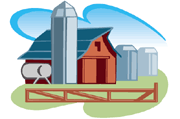Bulletin #2295, Maine Farm Safety Program: Storage Building Safety
 Bulletin #2295, Maine Farm Safety Program: Storage Building Safety (PDF)
Bulletin #2295, Maine Farm Safety Program: Storage Building Safety (PDF)
By Dawna L. Cyr, Farm Safety Project Assistant, and Steven B. Johnson, Ph.D., Extension Crops Specialist
For information about UMaine Extension programs and resources, visit extension.umaine.edu.
Find more of our publications and books at extension.umaine.edu/publications/.
Buildings in General
Make all buildings safe. See that the stairs have handrails and the permanent ladders are in good condition. The areas near the stairs and any other traffic patterns should be free from objects which could cause a fall. The floors should be free of debris. A little clean-up time could save a nasty fall. Regularly inspect and maintain floorboards. Replace soft or rotten ones. Check boards on upper stories for weak or rotten spots. Clean build-ups of dust, trash or spider webs. They can interfere with the electrical system and cause problems.
Another way to avoid injuries is through proper lighting. Light stairwells, storage and work areas, and other areas regularly used. When light bulbs are close to a work area, they can be bumped. Glass enclosures help, but a substantial guard would reduce the risk of breakage and fire.
- Make sure all storage buildings are safe.
- Keep stairs and other high traffic areas free from clutter.
- Keep a fire extinguisher of the correct type available.
- Ensure that heating equipment is properly installed and in good working order.
- Be aware of the dangers of carbon monoxide buildup from combustion engines.
Shops and Garages
Shop and garage areas harbor risks of all kinds. Remove objects leaning against walls, such as tires. Store ladders where children cannot reach them. Avoid creating piles of objects used in shops and garages that children can climb. Lock up pesticides, solvents, paint thinners, and other toxic chemicals and immediately dispose of empty containers. Keep gas cans out of reach. Install locking devices on electrical supply boxes. Wear the appropriate protective equipment when you perform tasks.
Organize and regularly clean shops and garages. The floors should be free from oil, grease, water or any other substance that could make the floor slippery. Keep the workbench, tools, and supplies handy. On the wall, mount a fire extinguisher of the correct type where it can be clearly seen. (“A” is for trash, wood, and paper; “B” is for liquids and grease, and “C” is for electrical equipment.)
Fuels and solvents contribute to farm shop fires and explosions. Ignition sources include open flame, gas-fired space heaters, and water heaters, furnaces, sparks from welding and grinding and smoking. Handle fuels and solvents only in well-ventilated areas and store them in secure containers. Use extreme caution with fuel spills. In addition to flame sources, fumes can be ignited by the sparks from switches in air compressors, refrigerators or even light switches.
Test electric garage door openers. Use a two-inch thick piece of wood at the bottom and close the door. If the door does not reverse, disable it and fix or replace the opener as soon as possible.
Carbon Monoxide in Buildings
Gasoline-powered or other internal-combustion engines give off carbon monoxide. It is a colorless, odorless and tasteless gas that gives no signs of its presence. Carbon monoxide can rapidly build up in any indoor area. Physical symptoms of carbon monoxide poisoning include confusion, headache, dizziness, fatigue, and weakness. A person can be quickly overcome and eventually die if they don’t get medical help. Carbon monoxide poisoning can cause permanent brain damage, including changes in personality and memory.
Operate internal-combustion engines indoors for only short periods of time and make sure the area is very well ventilated. Even small engines can produce deadly levels of carbon monoxide. Pressure washers used indoors have caused many carbon monoxide poisonings. If they are used, place the machines outside and bring the hoses inside.
Keeping buildings safe and clean will help prevent accidents and provide a better working environment for employees.
This Maine Farm Safety fact sheet is part of an educational fact sheet series produced by University of Maine Cooperative Extension. For more information on farm safety, contact your UMaine Extension County Office.
Information in this publication is provided purely for educational purposes. No responsibility is assumed for any problems associated with the use of products or services mentioned. No endorsement of products or companies is intended, nor is criticism of unnamed products or companies implied.
© 2003
Call 800.287.0274 (in Maine), or 207.581.3188, for information on publications and program offerings from University of Maine Cooperative Extension, or visit extension.umaine.edu.
The University of Maine is an EEO/AA employer, and does not discriminate on the grounds of race, color, religion, sex, sexual orientation, transgender status, gender expression, national origin, citizenship status, age, disability, genetic information or veteran’s status in employment, education, and all other programs and activities. The following person has been designated to handle inquiries regarding non-discrimination policies: Sarah E. Harebo, Director of Equal Opportunity, 101 North Stevens Hall, University of Maine, Orono, ME 04469-5754, 207.581.1226, TTY 711 (Maine Relay System).

